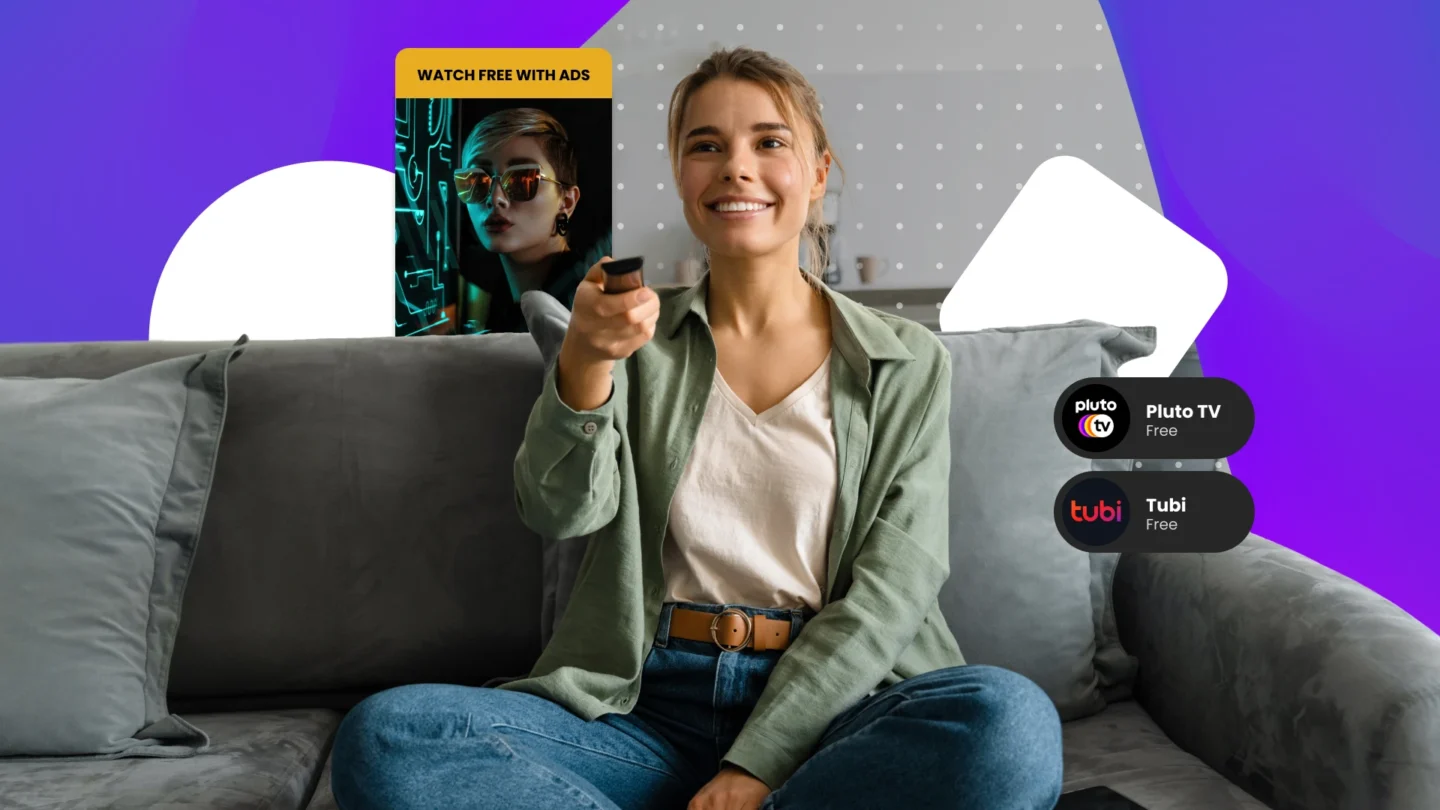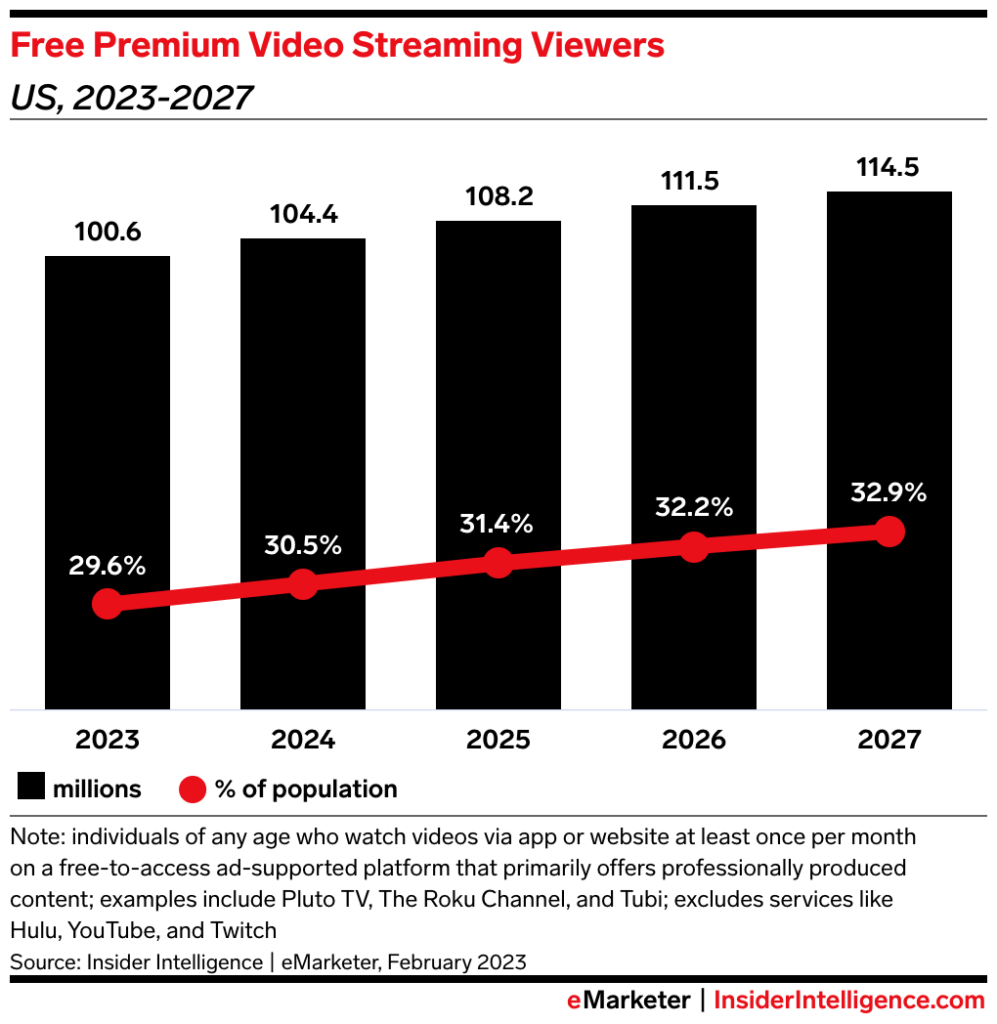What Are Free Ad Supported TV (FAST) Streaming Services?


In a world saturated with streaming options, Free Ad-Supported TV (FAST) channels are carving out a unique space, bridging the gap between traditional linear TV and modern on-demand viewing. According to an eMarketer forecast, nearly a third of the U.S. population will be free ad-supported streaming TV (FAST) viewers by 2027, accounting for a total of 114.5 million viewers. A large part of that is because viewers get the best of both worlds – curated content with the convenience of streaming, all while keeping it free through targeted advertising.
Curious about how FAST channels work and which of these streaming platforms are making waves? In this post, we’ll explore the ins and outs of FAST Channels, drawing parallels with linear TV and spotlighting rising platforms that are reshaping our television experience.
Free Ad-Supported TV (FAST) channels have become the latest buzz in the world of OTT advertising, offering viewers a unique blend of the familiar and the modern. Imagine a streaming service that mirrors the cable or traditional TV experience but comes with the perks of being free, accessible on your mobile device, and interspersed with commercial breaks.
Unlike subscription-based platforms like Hulu or Netflix, FAST channels follow a model where users can enjoy a variety of content without any upfront costs, relying on targeted advertising to fund the service. The distinguishing factor is the presentation – content is organized into channels, reminiscent of the linear TV approach. Users tune in to pre-set lineups, enjoying a mix of TV shows, movies, and news with scheduled ad breaks.
Diverse Content Offerings: TV Shows, Movies, and News
FAST channels bring a variety of content to viewers, ranging from TV shows and movies to news broadcasts. The majority of offerings might not boast blockbuster quality, often featuring older shows and films. However, the landscape is evolving, with more significant studios leasing content to FAST providers, expanding the variety and quality of available shows.
Accessing FAST Channels: Anytime, Anywhere
One of the appeals of FAST channels lies in their accessibility. These platforms usually exist as websites or apps, making them compatible with a wide array of devices. Whether you prefer watching on your mobile device, connected TV, streaming dongle, or computer, the flexibility is at your fingertips. While some FAST channels are exclusive to specific devices, others, like Tubi, can be accessed by anyone with an internet connection.
Example: Samsung TV Plus, exclusive to Samsung Smart TVs, contrasts with Tubi, which is accessible across devices with a simple app download.
Why Consumers Love FAST Channels
The love for FAST channels stems from their key attributes – they are free, often featuring shows viewers are already familiar with, and yet offer enough variety to help users discover new content. Another bonus is that, compared to many linear providers, the frequency of ads on FAST channels tends to be less intrusive, creating a more enjoyable viewing experience.
The Rapid Growth of FAST Channels
As the streaming advertising landscape continues to evolve, the growth of FAST channels is undeniable. With a model that aligns with changing consumer preferences and an increasing number of providers entering the scene, FAST channels are set to redefine how we consume content in the future.

In the world of streaming, understanding the distinctions between Free Ad-Supported TV (FAST) and Ad-Supported Video on Demand (AVOD) is crucial. Let’s dive into the intricacies of each and see how they differ.
Understanding AVOD: Ad-Supported Video on Demand
Ad-Supported Video on Demand (AVOD) is a streaming model where users can pick and choose content from a library, enjoying it on-demand at their convenience. Unlike traditional cable or FAST channels, AVOD platforms give users the freedom to decide what to watch and when to watch it, all while being supported by advertisements.
FAST Channels: More Than Just On-Demand
On the flip side, Free Ad-Supported TV (FAST) channels bring a different flavor to the streaming experience. Rather than allowing users to handpick content on demand, FAST channels emulate the linear TV model. Users tune into specific channels featuring predetermined lineups, creating a more “channel-surfing” experience.
The Hybrid Model: Where FAST and AVOD Converge
Interestingly, some FAST streaming services seamlessly blend into the realm of Ad-Supported Video on Demand. Take Tubi, for instance. Tubi not only offers a live channel experience where viewers tune in to a continuous feed, but it also provides on-demand content, allowing users to select what they want to watch.
For example, Tubi features a dedicated channel offering a nonstop stream of old episodes of The Masked Singer, catering to those who enjoy a scheduled lineup but also want the freedom to choose specific content.
While the line between FAST and AVOD can blur with hybrid models, the key distinction lies in the level of control viewers have over their content selection. Whether you prefer the curated lineup of a live channel or the flexibility of on-demand content, the streaming landscape has options tailored to your preferences.
There are a wide variety of FAST Channels available. Let’s dive into a few of the most popular and what they offer viewers.
1. Tubi
Tubi is a leading FAST platform, offering a diverse range of movies and TV shows for free with ad support. Acquired by Fox Corporation, Tubi has an extensive library, including popular titles, on-demand and classic content, making it a go-to for those seeking a wide variety without the subscription fee.
2. Pluto TV
Acquired by ViacomCBS, Pluto TV is a versatile FAST service with a unique twist. It provides a live TV-like experience, including on-demand viewing, organizing content into channels. With a broad range of genres and partnerships with major studios, Pluto TV offers an extensive array of free, ad-supported programming.
3. Roku Channel
Roku Channel, developed by the streaming device giant Roku, serves as a hub for various content. Offering a mix of movies, TV shows, and live news, it provides users with a seamless streaming experience on Roku devices, making it an attractive choice for Roku users seeking free, ad-supported content.
4. Freevee
Freevee is relatively new to the FAST landscape, offering a variety of channels with a focus on live linear programming. Positioned as a cost-effective alternative to traditional cable, Freevee delivers a curated selection of channels with ad support.
5. Samsung TV Plus
Samsung TV Plus, a service tied to Samsung Smart TVs, provides users with free access to live and on-demand content. With a mix of news, entertainment, and sports channels, Samsung TV Plus enhances the Smart TV experience for Samsung device users, supported by targeted advertising.
6. Google TV
Google TV incorporates a mix of both subscription and ad-supported content. While its subscription services compete with platforms like Netflix, the ad-supported side offers free movies and shows, complemented by personalized recommendations based on user preferences.
7. LG Channels
Exclusively available on LG Smart TVs, LG Channels provides users with a range of ad-supported channels spanning various genres. As part of the webOS platform, it enhances the LG TV viewing experience with a curated selection of free content.
8. Vizio WatchFree+
Vizio WatchFree+ is a FAST service embedded in Vizio SmartCast TVs, offering a mix of live channels and on-demand content. With a focus on providing a cable-like experience without the subscription cost, Vizio WatchFree+ is a noteworthy addition to the FAST lineup.
9. Xumo Play
Xumo Play offers a broad selection of live and on-demand content across genres. Acquired by Comcast, Xumo Play distinguishes itself with an easy-to-navigate interface and partnerships with major networks, providing users with an expansive range of free, ad-supported programming.
10. Vudu
Known for its digital video rental and purchase service, Vudu also features a free, ad-supported section. Offering a mix of movies and TV shows, Vudu’s ad-supported content provides users with additional options for streaming without a subscription fee.
In the rapidly evolving landscape of content consumption, advertising on Free Ad-Supported TV (FAST) channels emerges as a strategic avenue for marketers to connect with audiences in novel ways. Here’s a breakdown of why marketers should pay attention to FAST and what sets it apart:
Reach New Audiences
FAST channels present a unique opportunity for marketers to expand their reach and engage with audiences beyond traditional advertising channels. As a rising method of content consumption, FAST platforms attract diverse viewership, helping marketers tap into new demographics and markets.
Exploring Market Size
The market size of FAST TV is on a significant upward trajectory. With millions of users gravitating towards these platforms, marketers have the potential to reach a vast and growing audience. As budget-conscious consumers seek alternatives to rising subscription costs, FAST becomes an attractive space for advertisers to connect with viewers.
“The rise of FAST channels is undeniable. Nielsen’s latest data shows that Tubi alone has become larger in terms of audience time than premium networks such as Max and Paramount+; Tubi, Roku Channel, and Pluto combined outpace even Prime Video or Hulu. The model is working for viewers who want cheaper alternatives, for advertisers who want breadth of targeting and reach, and for platforms looking to challenge the incumbents. I expect that 2024 will see continued growth for these platforms, especially in terms of advertiser dollars, as this inventory can be a critical element of a successful full funnel integrated marketing campaign.”
Harry Browne, VP, Client Strategy & Analytics at Tinuiti
Targeting Niche Viewers
One of the unique strengths of advertising on FAST channels lies in the ability to target niche audiences with precision. Channels like the Gordon Ramsay or Top Gear channel on Tubi provide a tailored environment for marketers to showcase products and services directly related to the content. This laser-focused approach allows marketers to speak directly to their audience, enhancing the effectiveness of their campaigns.
Customizability
FAST channels offer marketers a customizable advertising experience, where prices and placements can vary significantly. This flexibility stands in contrast to the more rigid structures of traditional cable ad packages. The ability to tailor campaigns to specific budgets and target audiences allows marketers to optimize their strategies for maximum impact.
Rising Method of Content Consumption
As consumers increasingly seek cost-effective alternatives, FAST channels are witnessing a surge in popularity. Marketers should recognize this shift in content consumption patterns, adapting their strategies to align with the preferences of a growing audience on these platforms. By staying ahead of this trend, marketers can position their brands at the forefront of a changing media landscape.
Low Barrier to Entry
FAST platforms eliminate barriers to entry, making it easier for marketers to attract viewers without hefty customer acquisition and retention costs. This accessibility ensures that marketing budgets can be allocated more efficiently, focusing on creating compelling content and messaging rather than overcoming hurdles to entry.
Advertising on FAST channels is not just about embracing a trend; it’s about seizing a dynamic opportunity to engage with audiences in innovative ways. The benefits of expanded reach, customizable options, and the ability to connect with niche viewers make FAST a valuable addition to any marketer’s strategy. Interested in learning more about FAST Channels? Contact us today or check out our Streaming Services page for more information.
